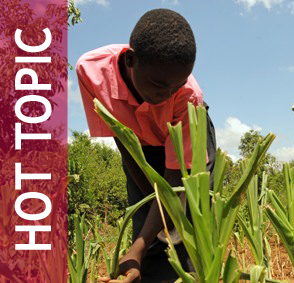{jathumbnail off} The economic, social and cultural contexts of agriculture are changing fast, as evidenced by significant shifts in the patterns of food production and consumption. An increasingly globalised world also means that there is now greater access to fast-evolving communication and media technology, which improves information flows and adds to the feeling that the world is getting smaller. However, development and growth processes still move at different speeds in different locations, even within countries.These inequalities are increasingly visible to people living in remote rural areas, often characterised by under-investment and slow growth.
The economic, social and cultural contexts of agriculture are changing fast, as evidenced by significant shifts in the patterns of food production and consumption. An increasingly globalised world also means that there is now greater access to fast-evolving communication and media technology, which improves information flows and adds to the feeling that the world is getting smaller. However, development and growth processes still move at different speeds in different locations, even within countries.These inequalities are increasingly visible to people living in remote rural areas, often characterised by under-investment and slow growth.
Against this backdrop, we also have the largest population ever of young people in the developing world. In all, there are roughly 1.5 billion people aged 12-24 worldwide, 1.3 billion of whom live in developing countries. Sub-Saharan Africa is home to over 200 million young people, three quarters residing in rural areas. Growth in the population of African youth is not projected to peak for another 20 years. Ironically, while there are more young people in the African population, across the continent the ageing of the farming population is causing concern. Young people are choosing not to pursue livelihoods in the agriculture sector, especially as farmers.
Recent policy dialogues on the future of food and farming facilitated by the Future Agricultures Consortium’s Ethiopia team point to the fact that it is not just the youth who have an aversion to farming. Their parents often hold the same view, preferring their children to move away from rural areas entirely because they associate rural life with poverty.
A recent IDS-University of Ghana study of young people in cocoa farming communities paints a mixed picture of attitudes towards farming, but with strong indications that cocoa farming is not seen as an attractive area of work. The minority who could see a future for themselves in cocoa farming all expressed a wish not to farm in the same way as their small-holder parents. Rather, they saw themselves managing mechanised farms with more technical inputs.
These changing aspirations present considerable challenges and opportunities – for young people themselves, for rural communities and for the agricultural sector. While young Africans are increasingly mobile, many still live in rural areas, and agriculture and rural employment will continue to play a key role in the livelihoods of many. Thus, productivity-led agricultural growth is needed to create forward and backward linkages and new rural employment opportunities.
But what is the scope for agricultural growth and rising employment in different parts of rural Africa? What policies should African countries adopt to support growth that maximises employment creation? What programmes can be developed and implemented that will benefit large numbers of rural youth? What activities and approaches – training and education, strengthening of rural organisations, investments in new technologies, value addition and income-generation, etc. – will give Africa’s rural youth the knowledge and skills they need to benefit from and contribute to more vibrant rural economies? Researchers and policy makers have only just begun to consider these questions.
To fill this gap, the Future Agricultures Consortium is embarking on new research, outreach and engagement activities over the next three years that will explore how policies and institutions, including social protection measures, can support Africa’s rural youth to flourish, tapping into their energy, creativity and willingness to take risks and innovate in ways that bring about productive outcomes and improved livelihoods.
Jennifer Leavy
December 2009
